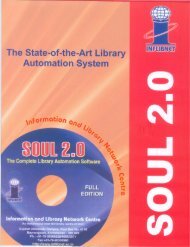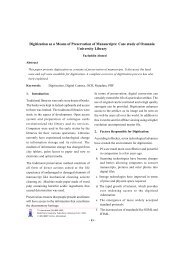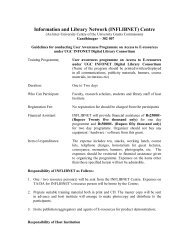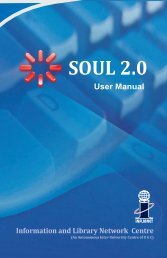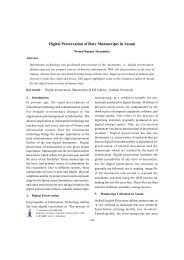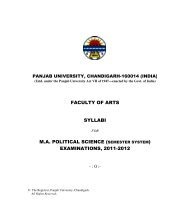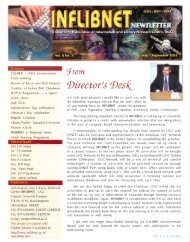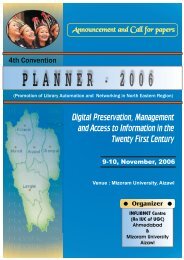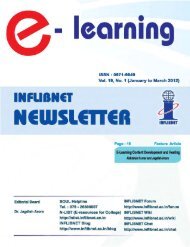Drupal: The Open Source Content Management System Software ...
Drupal: The Open Source Content Management System Software ...
Drupal: The Open Source Content Management System Software ...
You also want an ePaper? Increase the reach of your titles
YUMPU automatically turns print PDFs into web optimized ePapers that Google loves.
7 th International CALIBER 2009 <strong>Drupal</strong>: <strong>The</strong> <strong>Open</strong> <strong>Source</strong> <strong>Content</strong> <strong>Management</strong> <strong>System</strong> ...<br />
<strong>Drupal</strong>: <strong>The</strong> <strong>Open</strong> <strong>Source</strong> <strong>Content</strong> <strong>Management</strong> <strong>System</strong> <strong>Software</strong> Suit For<br />
Library With Library 2.0 Features<br />
Abstract<br />
M R Rawtani S Siva Chidambaram<br />
<strong>The</strong> purpose of this paper to inform LIS professionals about the benefits of using <strong>Open</strong> <strong>Source</strong><br />
<strong>Content</strong> <strong>Management</strong> <strong>System</strong> <strong>Software</strong> DRUPAL. This article will discuss about the importance of<br />
<strong>Content</strong> <strong>Management</strong> <strong>System</strong> for organizing and facilitating, collaborative, creation of electronic<br />
documents. “<strong>Drupal</strong> a hammer that strikes many mails in the <strong>Content</strong> <strong>Management</strong> <strong>System</strong>” with in<br />
the context of Web 2.0 or Library 2.0 environment. It is ten years old mature open source project<br />
developed by Dries Buytart with Dutch word “Dorpje” in English it means “little village”. Being a<br />
social publishing system, it has been adopted by large number of webmasters and library and<br />
information professionals. This paper will highlights the silent features of <strong>Drupal</strong> with special<br />
reference to Library 2.0. <strong>Content</strong> <strong>Management</strong> <strong>System</strong>. Blogs, RSS and Social Networking Site.<br />
Brief description of <strong>Drupal</strong> used library websites <strong>Drupal</strong>Lib and etc., finally this paper will focus in<br />
detail with conclusion of “<strong>Drupal</strong> is multifaceted <strong>Content</strong> <strong>Management</strong> <strong>System</strong> which includes<br />
weblogs forums, tagging and social networks”.<br />
Keywords: <strong>Drupal</strong>, Web 2.0, <strong>Content</strong> <strong>Management</strong> <strong>System</strong>s<br />
1. Introduction<br />
<strong>Content</strong> is a king, Library is his Palace and<br />
Librarian is a Governor to regulate and govern the<br />
content management. Being in the digital world at<br />
hybrid library movement in web environment,<br />
content is granular information it would be text,<br />
graphics, pictures, sounds videos and data etc.,<br />
Greater challenge of library and information science<br />
professionals is how to manage this granular<br />
information in the dynamic web environment.<br />
Traditional content management software does like<br />
old proverb “garbage in – garbage out”. <strong>The</strong> way<br />
in which content is managed with in the overall<br />
content management life-cycle from creation to<br />
dissemination is the content management system.<br />
It is a tool that enables a variety of (centralized)<br />
technical and (de-centralized) non technical staff<br />
7 th International CALIBER-2009,<br />
Pondicherry University, Puducherry, February 25-27, 2009<br />
© INFLIBNET Centre, Ahmedabad<br />
- 176 -<br />
to create, edit, manage and finally publish (in a<br />
number of formats) a variety of content (such as<br />
text, graphics, video and document etc), which<br />
being constrained by a centralized set of rules,<br />
process and workflows that ensure coherent,<br />
electronic content. Implementing content<br />
management system in Library, Library web site<br />
environment needs the content management<br />
strategy. <strong>The</strong> elements of content management<br />
strategy has figured by Martin White in his book<br />
entitle “<strong>The</strong> <strong>Content</strong> <strong>Management</strong> Handbook” is a<br />
road map to frame the strategy.<br />
Choosing content management software with<br />
Library 2.0 feature is important task in the fast<br />
development of information format containers.<br />
While searching the literature for the CMS the open<br />
source <strong>Content</strong> <strong>Software</strong> <strong>Drupal</strong> has been<br />
implemented in large number of academic libraries.<br />
<strong>The</strong> major benefit of open source software is<br />
community of users that supports the product. <strong>The</strong>
<strong>Drupal</strong>: <strong>The</strong> <strong>Open</strong> <strong>Source</strong> <strong>Content</strong> <strong>Management</strong> <strong>System</strong> ... 7 th International CALIBER 2009<br />
founder of <strong>Drupal</strong> and many contributors or <strong>Drupal</strong><br />
have Masters or PhD degrees in computer science<br />
or other programming related fields. Other key<br />
contributor of decade old software is developer<br />
through their development experience while<br />
cooking in <strong>Drupal</strong>. According to this handbook the<br />
growth of developer’s code contributions is doubled<br />
in last two releases (<strong>Drupal</strong> version release 5 & 6).<br />
<strong>The</strong> indicator of the collaborative participation of<br />
the growth and development of the <strong>Drupal</strong> project<br />
highlights are as follows. Financial award been<br />
given by Google’s summer of code program year<br />
2007 and 2008 was over $100,000 per year. Knight<br />
foundation, Knight Challenge which awards $5<br />
million a year. In 2008 the Knight foundation<br />
established the “Knight <strong>Drupal</strong> Initiative”. In July<br />
2006, IBM chooses <strong>Drupal</strong> out of all other CMS to<br />
be a content system in their open source<br />
development suit. (See –Figure 1: CMS<br />
Requirements Matrix)<br />
(IBM Engineers Says “We also felt that <strong>Drupal</strong><br />
provided the right combination of framework and<br />
flexibility to break out of the framework when<br />
needed to get the job done. With all things<br />
considered, we decided to use <strong>Drupal</strong>.”)<br />
Figure 1: CMS Requirements Matrix (source : http://www-<br />
128.ibm.com/developerworks/ibm/library/i-osource1/#fig3)<br />
- 177 -<br />
Packt publishing has judged in 2007 <strong>Drupal</strong> is the<br />
best CMS and score its first place. In early 2008,<br />
<strong>Drupal</strong> won a CNET Web ware 100 courses in the<br />
publishing category. Such patronage helps <strong>Drupal</strong><br />
stand out among the dozens of other choice of<br />
content management systems.<br />
This article highlights the basic building blocks of<br />
the <strong>Drupal</strong> software. It will be a useful primer on<br />
<strong>Drupal</strong> growth and development, silent feature of<br />
the open source content management system with<br />
in the context of Library 2.0. Emphasis and<br />
concentrate on the easiness of the using <strong>Drupal</strong> as<br />
the CMS package in Library environment, what are<br />
all the Web 2.0 characters that <strong>Drupal</strong> has? As many<br />
other best CMS packages are there in fee and free<br />
based, why library choose the <strong>Drupal</strong> software will<br />
be explained in detail. As said by Austin and Harris<br />
(2008) while choice is nice the prospect of<br />
downloading and installing multiple systems to test<br />
them probably sounds a bit daunting. Do not<br />
despair: open source CMS has collected dozens of<br />
systems and provides full administrative access to<br />
each so that you try out all of them in one place i.e.<br />
<strong>Drupal</strong>.<br />
2. What is <strong>Drupal</strong>?<br />
In Dutch Druppel means drop in English and it is<br />
pronounces <strong>Drupal</strong>. Dries Buytaert, Belgium<br />
student wants to create message board for sharing<br />
information at Local Area Network then it’s become<br />
web board on the internet environment. Drop.org<br />
web site has developed and distributed open source<br />
web platform. Since, graduation Dries has<br />
developed along with his higher studies. <strong>Drupal</strong> is<br />
software that allows an individual or a community<br />
of users to easily publish, manage and organize a<br />
great variety of content on a Web site. Tens of<br />
thousands of people and organizations have used
7 th International CALIBER 2009 <strong>Drupal</strong>: <strong>The</strong> <strong>Open</strong> <strong>Source</strong> <strong>Content</strong> <strong>Management</strong> <strong>System</strong> ...<br />
<strong>Drupal</strong> to set up scores of different kinds of Web<br />
sites, including:<br />
� Community Web portals and discussion sites<br />
� Corporate Web sites/intranet portals<br />
� Personal Web sites<br />
� E-commerce applications<br />
� Resource directories<br />
<strong>Drupal</strong> includes features to enable content<br />
management systems, blogs, collaborative<br />
authoring environments, forums, newsletters,<br />
picture galleries, file uploads and download, and<br />
much more. <strong>Drupal</strong> is open source software licensed<br />
under the GPL and is maintained and developed by<br />
a community of thousands of users and developers.<br />
<strong>Drupal</strong> is free to download and use.” He got<br />
financial support from Acquia. <strong>Drupal</strong> 6.0 version<br />
has come up. It is an open-source platform and<br />
content management system for building dynamic<br />
web sites offering a broad range of features and<br />
services including user administration, publishing<br />
workflow, discussion capabilities, news<br />
aggregation, metadata functionalities using<br />
controlled vocabularies and XML publishing for<br />
content sharing purposes. Equipped with a powerful<br />
blend of features and configurability, <strong>Drupal</strong> can<br />
support a diverse range of web projects ranging from<br />
personal weblogs to large community-driven sites.<br />
It is developed in PHP and Supports MySQL and<br />
PostgreSQL databases.<br />
January 15, 2009 is the eighth (8 th ) year Happy<br />
Birthday for <strong>Drupal</strong>. <strong>Drupal</strong> 1.0 was released on<br />
these days only. Now the big release of <strong>Drupal</strong> 6<br />
with a lot of awards Jeff Robbins says “<strong>Drupal</strong> will<br />
save the world” for Howard Dean campaign used<br />
<strong>Drupal</strong> to create DeanSpace, later named CitySpace.<br />
Why <strong>Drupal</strong> is as best CMS?<br />
1. Learning Curve<br />
- 178 -<br />
After basic installation is over <strong>Drupal</strong> can be used<br />
as content management system. <strong>The</strong>n it can be<br />
develop as a website with their applications. Further<br />
in out box it can produce a dynamic website. From<br />
CMS to website and to website and then dynamic<br />
website is the development through learning and<br />
further if you interested one can start writing your<br />
own code. It provides you a powerful set of internal<br />
application protocol interface to streamline your<br />
coding.<br />
2. <strong>Content</strong> <strong>Management</strong> Framework<br />
<strong>Drupal</strong> has already used in different tasks like public<br />
web site, extranet, shared electronic purchasing<br />
system, shared department calendars, project<br />
management, book marks, and blogs. Hence the<br />
<strong>Drupal</strong> community often refers to <strong>Drupal</strong> as a<br />
content management framework. It shows that<br />
<strong>Drupal</strong> is not a fixed system but a framework on<br />
which you can build your own Library 2.0 services.<br />
3. Abstraction<br />
<strong>Drupal</strong>’s power comes from it’s more abstracted<br />
approach to handling web content and functionality.
<strong>Drupal</strong>: <strong>The</strong> <strong>Open</strong> <strong>Source</strong> <strong>Content</strong> <strong>Management</strong> <strong>System</strong> ... 7 th International CALIBER 2009<br />
People often think of a website as a collection of<br />
pages, with some functions (like a blog, or a news<br />
engine) thrown in to round it out. When they go to<br />
manage their site, they are thinking in terms of a<br />
tree-like hierarchy of pages that they will go in and<br />
edit. <strong>Drupal</strong>, on the other hand, treats most content<br />
types as variations on the same concept: a node<br />
(more on these in a moment). Pages, blog posts, &<br />
news items (some possible node types) are all stored<br />
in a common pool, and the sitemap (its information<br />
architecture) is an overlay that is designed<br />
separately by managing and editing navigation<br />
menus. It’s a lot like the separation you find in<br />
standards-compliant page coding – XHTML<br />
provides the meaningful structure of the<br />
information, while CSS arranges it for presentation.<br />
In <strong>Drupal</strong>, nodes hold the structured information<br />
pertaining to a blog post (such as<br />
title, content, author, date) or a news item (title,<br />
content,<br />
go-live date, take-down date), while the mending<br />
system creates the sitemap as a separate layer. Other<br />
elements (node layout themes and modules like<br />
Views and Panels) provide the onscreen display of<br />
node contents. This principle of manageable<br />
abstraction is important to understand, because it<br />
is a central concept to all things <strong>Drupal</strong>. When you<br />
understand why a measured amount of abstraction<br />
is valuable, you’ll begin to understand why this<br />
approach is such a strong argument for using<br />
<strong>Drupal</strong>.<br />
4. Library Portal<br />
<strong>Drupal</strong> will be next generation web 2.0 Library<br />
portal. <strong>The</strong>re are some prominent screenshot of the<br />
latest and famous library portal constructed through<br />
<strong>Drupal</strong>. Fish4Info is a library catalog builds in<br />
<strong>Drupal</strong> along with book review, pathfinders and<br />
much more. It is based on the MARC module.<br />
SOPAC – Social OPAC<br />
Social OPAC (http://www.blyberg.net/2007/01/21/<br />
aadlorg-goes-social/), it’s basically a set of social<br />
networking tools integrated into the AADL<br />
catalogue. It gives users the ability to rate, review,<br />
comment-on, and tag items. <strong>The</strong> “front door” to<br />
the SOPAC is, of course, the main catalogue search<br />
screen. <strong>Drupal</strong>’s API made development of this code<br />
relatively painless.<br />
Catalogue building through <strong>Drupal</strong>:<br />
http://chicagolibrarian.com/node/262 : Screencast:<br />
Creating a Library Database Page with <strong>Drupal</strong> by<br />
Leo Klein, an American librarian, who started the<br />
<strong>Drupal</strong>4lib discussion list, has produced an<br />
impressive screen-cast showing how to combine<br />
different modules to quickly set up a database<br />
catalogue on the Website of a library.<br />
- 179 -
7 th International CALIBER 2009 <strong>Drupal</strong>: <strong>The</strong> <strong>Open</strong> <strong>Source</strong> <strong>Content</strong> <strong>Management</strong> <strong>System</strong> ...<br />
Creating collaborative documentation<br />
Biblioscape (http://support.biblioscape.com) this is<br />
a set of node hierarchically organized with a table<br />
of content. <strong>Drupal</strong> handles rights management and<br />
may store the different versions of a node. An<br />
interesting example is the support site of In this<br />
case; the edition is limited to a specific group of<br />
editors.<br />
Biblioscape (http://support.biblioscape.com)<br />
- 180 -<br />
Collaborative support for <strong>Drupal</strong> Developer<br />
Silent features of <strong>Drupal</strong> with the context CMS<br />
and Library 2.0<br />
Librarians are not only content creators or<br />
contributors, but also facilitators who disseminate<br />
information. At the same time, users have the ability<br />
to find out about the library virtually, have a place<br />
where they can interact with the librarian, learn<br />
what they need when there is a need, and contribute<br />
and participate accordingly. <strong>Drupal</strong>, users and<br />
librarians unite through virtual channels where they<br />
are interacting, communicating, sharing, and<br />
contributing via Web 2.0 applications. Michael C.<br />
Habib (2006) proposed Library 2.0 describes a<br />
subset of library services designed to meet user<br />
needs caused by the direct and peripheral effects of<br />
Web 2.0 services leveraging concepts of the Read/<br />
Write Web, the Web as Platform, <strong>The</strong> Long Tail,<br />
harnessing collective intelligence, network effects,<br />
core datasets from user contributions, and<br />
lightweight programming models.
<strong>Drupal</strong>: <strong>The</strong> <strong>Open</strong> <strong>Source</strong> <strong>Content</strong> <strong>Management</strong> <strong>System</strong> ... 7 th International CALIBER 2009<br />
According to <strong>Drupal</strong> web site technical and<br />
functional definition of “<strong>Drupal</strong> is a web-based<br />
content management system. Text and pointers to<br />
other kinds of content are stored in a database,<br />
dynamically retrieved and composed, and presented<br />
to a user in response to a request sent via a web-<br />
browser.” <strong>Drupal</strong> is also a blogging engine, which<br />
allows items to be posted and commented on, on a<br />
regular basis (almost like a conversation). <strong>The</strong>y can<br />
be extremely useful for internal as well as external<br />
communication between people and organizations.<br />
(Wikipedia)<br />
Basically <strong>Drupal</strong> has Modular architecture the<br />
benefits are enlisted as bullet point that are<br />
follows;<br />
Intranet Home Page<br />
URL – Friendly URL (user & Search Engine)<br />
Web based administration, Browser based<br />
User desktop<br />
WYSIWYG and client-side document editing<br />
Schedule Publishing<br />
Calendar management (events, tasks and<br />
journals)<br />
Forums (threaded message areas)<br />
Contact management<br />
Search engine<br />
Project artifacts management<br />
Collaborative workflow<br />
Document/ asset library<br />
Repository and Metadata <strong>Management</strong><br />
Online help<br />
Conversion and re-purposing<br />
Developing and extending<br />
� application server<br />
� page templates<br />
� event subsystem<br />
� schema-based development<br />
End user personalization<br />
<strong>System</strong> administration<br />
- 181 -<br />
� Security (SSL login)<br />
� platform portability<br />
� user authentication<br />
� user authorization<br />
� External system integration.<br />
Infrastructure for <strong>Drupal</strong> Implementation:<br />
<strong>Drupal</strong> is open-source software distributed under<br />
the GPL (“GNU General Public License”). <strong>Drupal</strong><br />
6.9 is the latest version. It is ready to go from the<br />
moment you download it. It even has an easy-touse<br />
web installer! <strong>The</strong> built-in functionality,<br />
combined with dozens of freely available add-on<br />
modules. If you like what <strong>Drupal</strong> promises for you,<br />
please work with us to expand and refine <strong>Drupal</strong> to<br />
suit your specific needs. http://drupal.org/ website<br />
boasts more than 80,000 registered users. Since it<br />
is open-source software, it relies heavily on<br />
contributions from its users, and it incorporates and<br />
builds upon numerous other open-source projects.<br />
Users contribute to the software in two primary<br />
ways: 1) by creating “modules” that enhance or add<br />
to <strong>Drupal</strong>’s features, or 2) by creating “themes” that<br />
alter the visual appearance of <strong>Drupal</strong>-powered<br />
websites. <strong>The</strong> <strong>Drupal</strong> website offers hundreds of<br />
user-contributed modules and themes, all of which<br />
can be customized to meet the needs of individual<br />
users.<br />
<strong>Drupal</strong> is written in PHP and stores its data in an<br />
SQL database. <strong>Drupal</strong> runs on Windows/MAC and<br />
Linux servers. To try <strong>Drupal</strong> on windows computer,<br />
you can download and install XAMPP, Single<br />
windows program that provides an easy to usage<br />
package of Apache, MySQL, and PHP, XAMPP is<br />
a free download.<br />
To install <strong>Drupal</strong>, users download the software<br />
package from the <strong>Drupal</strong> website, and then upload<br />
the files to a web server. After creating an SQL<br />
database run an installation script in their browser
7 th International CALIBER 2009 <strong>Drupal</strong>: <strong>The</strong> <strong>Open</strong> <strong>Source</strong> <strong>Content</strong> <strong>Management</strong> <strong>System</strong> ...<br />
that configures the database and creates the default<br />
site. Users then create the first account on the<br />
system, which becomes the default administrator<br />
account. <strong>The</strong> user of this account has access to all<br />
levels of the site and can create other users, assign<br />
privileges to new users, restrict access to certain<br />
parts of the site, and so on. Because this first user<br />
account has unlimited power, users who are new to<br />
running server-based applications may wants to<br />
create a second account for everyday use, reserving<br />
the first account for upgrading the website and<br />
performing administrative functions. Once the<br />
software is running, customizing <strong>Drupal</strong> for<br />
educational use is a fairly simple process. Users<br />
can give the website a name. Logo, a mission<br />
statement, and even a logo, if desired. Several types<br />
of “content” can then be added to the site, from<br />
weblog entries to course policy documents to forum<br />
posts. Each type of content can be customized (or<br />
disabled altogether) to meet the needs of a particular<br />
course. By default, the home page of a <strong>Drupal</strong> site<br />
contains the most recently added content, listed in<br />
reverse-chronological order. This organizational<br />
scheme is ideal for educational settings, as students<br />
visiting the website will always see the most recent<br />
updates and announcements at the top of the page.<br />
<strong>Drupal</strong> Architecture<br />
Three main building blocks of <strong>Drupal</strong> are: Nodes,<br />
Core Modules and <strong>The</strong>mes. Its architecture is<br />
modular. It has core modules which have functions<br />
for content and user management. Node is the basic<br />
information element. A node is constituted of a title,<br />
a teaser and a content bloc. It<br />
layout of the website. <strong>The</strong>se themes are written in<br />
the PHP.<br />
Building Blocks of <strong>Drupal</strong><br />
1. At the core of the system is the big bucket of<br />
nodes – the data pool. Before anything can be<br />
displayed on the site, it must be input as data.<br />
2. <strong>The</strong> next layer out from the center is where<br />
modules live. Modules are functional plug-ins<br />
that is either part of the <strong>Drupal</strong> core (they ship<br />
with <strong>Drupal</strong>) or they are contributed items that<br />
have been created by members of the <strong>Drupal</strong><br />
community. Modules provide various<br />
functionality to expand your site’s capabilities<br />
to include things like the creation of custom<br />
data points (fields) for your nodes; event<br />
calendars; e-commerce; programmatic sorting<br />
and display of content (custom output keyed<br />
off of any number of configurable parameters<br />
that interrelate your content); and more. <strong>The</strong>re<br />
are hundreds of different options within the<br />
fast growing repository of contributed <strong>Drupal</strong><br />
modules. <strong>The</strong>y represent the work of everyone<br />
from individuals to large corporations like Sony<br />
who use and rely on <strong>Drupal</strong> and are working<br />
has also some properties like the place published to extend its power and usefulness.<br />
(first page or not), the comments options, the<br />
classifications, etc. <strong>The</strong>me describes the look and<br />
feel of the website. <strong>Drupal</strong> comes with a set of<br />
default themes which can be used to change the<br />
3. At the next layer, we find blocks & menus.<br />
Blocks often provide the output from a module,<br />
and can be placed in various spots in your<br />
- 182 -
<strong>Drupal</strong>: <strong>The</strong> <strong>Open</strong> <strong>Source</strong> <strong>Content</strong> <strong>Management</strong> <strong>System</strong> ... 7 th International CALIBER 2009<br />
template (theme) layout. Blocks can be<br />
configured to output in various ways, as well<br />
as only showing on certain defined pages, or<br />
only for certain defined users.<br />
4. Next are user permissions. This is where<br />
settings are configured to determine which<br />
things different user types have access to.<br />
Permissions are assigned to<br />
various roles, and in turn, users are associated<br />
with those various roles in order to grant them<br />
the associated permissions.<br />
5. On the surface layer is the site template. This<br />
is made up predominately of XHTML and CSS,<br />
with some PHP tokens sprinkled throughout<br />
to insert content from the system into the<br />
correct spots. Also included with each template<br />
is a set of functions that can be used to override<br />
standard functions in the modules in order to<br />
provide complete control over how the modules<br />
generate their markup at output time.<br />
Templates can also be assigned on-the-fly based<br />
on user permissions.<br />
Conclusion<br />
Being over all view of Library 2.0 and the gap<br />
between Web Site , Repositories, Courseware Blogs,<br />
and RSS, <strong>Drupal</strong> is bridging software for Library<br />
2.0 services. <strong>Drupal</strong> certainly is suit for<br />
multifaceted Library 2.0 service module with<br />
<strong>Content</strong> <strong>Management</strong> <strong>System</strong> in Libraries.<br />
<strong>Drupal</strong>Lib and <strong>Drupal</strong>4Lib are the <strong>Drupal</strong> group<br />
of Librarian forum and mailing list respectively<br />
interact and explore the knowledge form these Web<br />
2.0 services. It is a decade old mature open source<br />
CMS package and social publishing system<br />
particularly academic library management system.<br />
Large number of libraries using <strong>Drupal</strong> as a<br />
- 183 -<br />
courseware. It has very rich module with library<br />
technical aspects like MARC module, and<br />
Bibliography module etc.<br />
References<br />
1. Bramscher, Paul F. and Butler, John T.<br />
LibData to LibCMS: One library’s evolutionary<br />
pathway to a content management system.<br />
Library Hi Tech (2006), Vol.24 (1), pp. 14-28<br />
2. Chalon, Patrice. Drop in: <strong>Drupal</strong> for libraries.<br />
Journal of European Association for Health<br />
Information and Libraries (2008), Vol.4 (3),<br />
pp. 40-41<br />
3. “<strong>Drupal</strong>.org,” http://drupal.org/ (accessed<br />
January 10, 2009).<br />
4. Mooney, Sean D. and Baenziger, Peter H.<br />
Extensible open source content management<br />
systems and frameworks: A solution for<br />
many needs of a bioinformatics group.<br />
Briefings in Bioinformatics (2007), Vol.9 (1),<br />
pp. 69-74<br />
5. Secker, Jane. Social software and libraries: A<br />
literature review from the LASSIE project.<br />
Program: Electronic Library and Information<br />
<strong>System</strong>s (2006), Vol.42 (3), pp. 215-231<br />
About Authors<br />
Dr. M R Rawtani, Associate Professor and Head,<br />
Department of Library & Information Science,<br />
University of Rajasthan, JAIPUR – 302004.<br />
E-mail: mr1@bsnl.in<br />
Mr. S Siva Chidambaram, Senior Library and<br />
Information Officer, National Institute of Public<br />
Finance and Policy (NIPFP), New Delhi.<br />
E-mail: sivanipfp@gmail.com


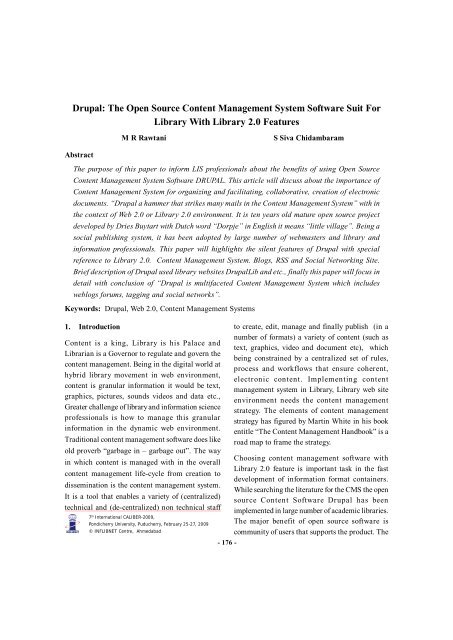
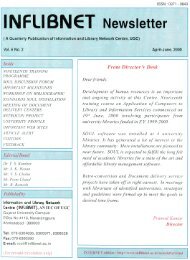

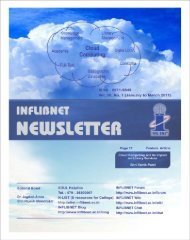

![Uni of Delhi_MA_History[1]. - INFLIBNET Centre](https://img.yumpu.com/48586372/1/190x245/uni-of-delhi-ma-history1-inflibnet-centre.jpg?quality=85)
